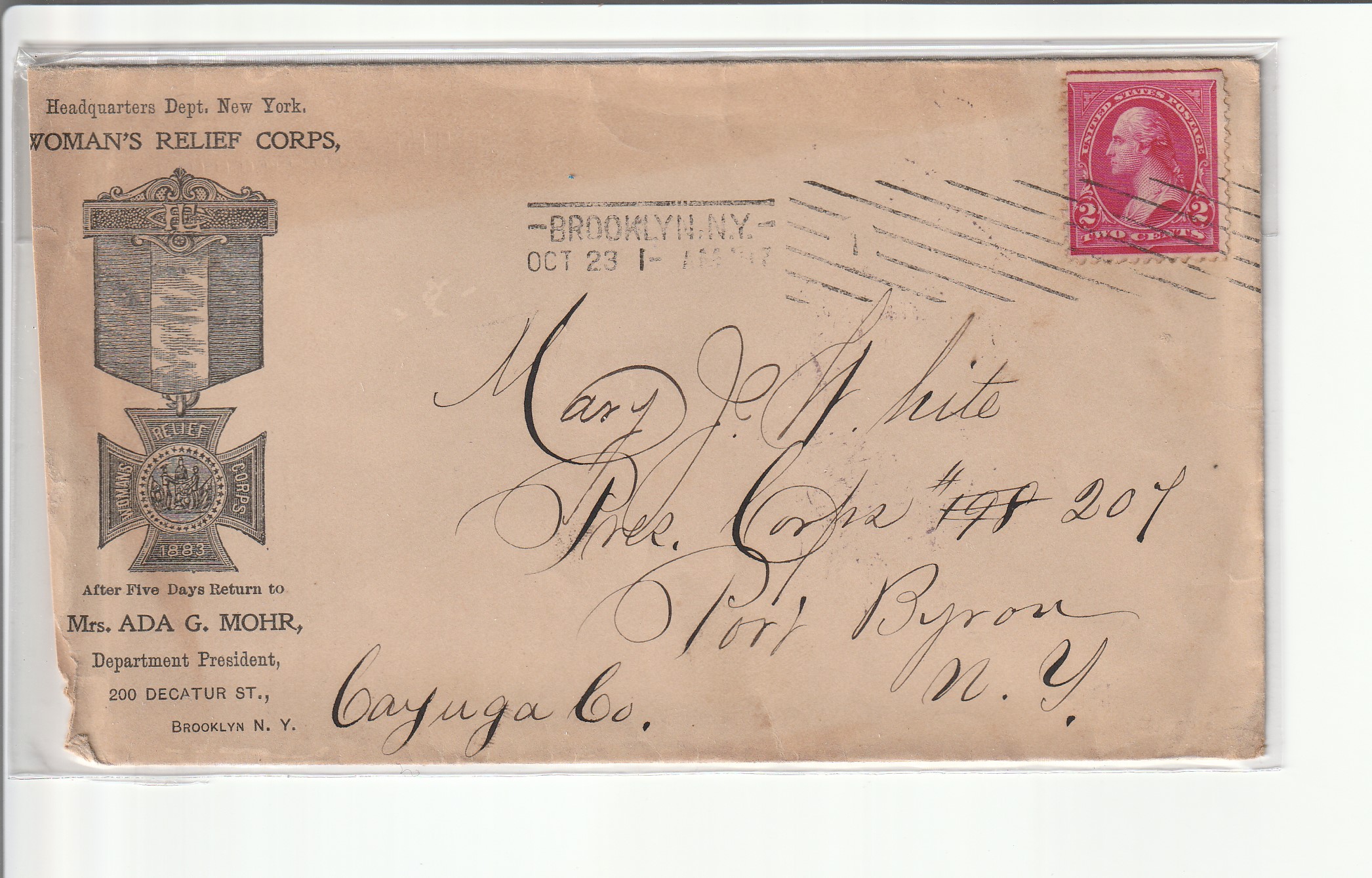A friend of the Society sent in a scan of an envelope which was addressed to Mary J White, Pres[sident] Corps #207, Port Byron, NY. The sender was Mrs. Ada Mohr of Brooklyn, who was the President of the Woman’s Relief Corps. The question was if I had ever heard of this group?
There are times when such a simple question can led to many great discoveries that have nothing to do with the original question, and this was one of them. Let’s start with the question. According to the internet, the Woman’s Relief Corps was a auxiliary organization of the G.A.R., otherwise known as the Grand Army of the Republic. Founded in 1879 the organization sought out women who were loyal to the North during the Civil War. Any woman could join, even those who were born after the war, as long as they were loyal to the North. The mission of the WRC was to assist the GAR, promote Memorial Day, promote patriotic education, and other things. In 1907, the local paper noted that the organization had a membership of 155,000 nationally, and it’s principle function was to be a fund raiser for GAR events. Mary was indeed an active member of the WRC, as in 1918, she traveled to Portland, Oregon to attend the 52nd encampment of the GAR. Other mentions show that Mary White often traveled to meetings and encampments with her daughter Mary Stickle of Weedsport. Both women were widowed young and spent a lot of time together.
One of the things I like to do when I am posed with such a question to is start a family tree and then try to find out who this person was. And then look for the connection that will allow me to include them in the Port Byron Family Tree.
Mary White nee Armstrong was the wife of Captain James White. Her obituary noted that she was from one of the pioneer families of Port Byron. As Armstrong was not a name I was familiar with, it was time to dig.
Her father was Abner Armstrong and her mother was Mary Jane Stevens. Abner was born in Newburgh and moved to Port Byron in the 1840s to start farming. By 1858 he had built a large warehouse and shipping business on the Erie Canal. In 1865 he sold the business to his sons who then ran it as the Armstrong Brothers. It was reported that the brothers employed many boaters who shipped grain to New York City and returned with loads of coal. This business was on the corner of Main Street and the canal. This would later be the site of Warren’s Lumber and Coal Yard. In 1887 this business caught fire and many of the buildings burned to the ground. As the fire burned the embers flew across the street and onto the Presbyterian Church. The steeple caught fire and was destroyed.
And here is an aside. In our cemetery walk last fall I had noted the grave of Jonathon Harnden. For years Jonathon was the keeper of the large clock in the Presbyterian steeple. He had noted how the newly rebuilt 1887 steeple was not as strong a structure as the older steeple. In 1998 this steeple would be blown over by the Labor Day storm. Hum!
Abner would be involved in an interesting law suit when he caused harm to a young lady who was trying to pick cherries for a cherry pie. A large cherry tree grew in the yard of his neighbor Dr. Hoffman, and some branches reached out over Armstrong’s fence and into his yard. In 1864 Sarah Hoffman was attempting to pick the remaining cherries from her tree which happen to be on Abner’s side of the fence.(The paper says that branches, “held a goodly supply of luscious, ruby, gastronomic joy.”) Abner told her to stop picking his berries and grew upset as the women refused to cease her quest. As Abner shook the fence she was leaning against, she fell and was slightly injured. The case went to court. Who owns the fruit of the tree if the branch grows over into another yard? As you might expect this legal question had been litigated many times prior, and the law states that whoever owns the trunk owns the fruit. Abner lost his case and the following appeals. If you wish to know more, do a search for “Hoffman vs Armstrong.”
Many in the Armstrong family led quite remarkable lives. Grand-daughter Margaret went to Boston University in 1888 to become a doctor. She may have been in the same class with Clara Barrus, and it certainly means that Port Byron sent two women off to become doctors at a time when this was not a common occurrence. Margaret went on to become a missionary in India, and upon her return with her new pastor husband, she busied herself in many educational pursuits. Later in life when she lost her sight, she taught herself Braille and continued to teach. It is a family we don’t hear about, but they certainly a major part in our busy canal village.
What was very exciting was that we were able to pull this family into the larger tree by way of Sarah Armstrong, the daughter of Nyrum and Sarah (Williams) Armstrong. She married Stephen D. Gutchess (the Mincemeat guy), who a member of the tree!
All this came from a question about an envelope.
